By the Unlock the Box Campaign
There is a growing movement across the United States to end or restrict solitary confinement and to employ alternative interventions that improve safety and well-being. Fueling this surge in efforts at ending solitary is a recognition that solitary confinement is a form of torture. It inflicts terrible suffering and injury—physical, psychological, emotional, and social—on individuals who have experienced it or are currently subjected to it and has severe effects on their loved ones and on the wider community. This horrific practice is in extensive use across the country, damaging or destroying untold lives. Deeply disturbed by this reality, an increasing number of campaigns led by people who have survived solitary confinement and those with loved ones in solitary now or in the past have helped spur legislative and administrative policy changes to curb the use of solitary and to promote alternatives. Between 2009 and 2022, in 45 states, 886 bills were introduced to restrict or end solitary confinement in some form; 40 states have passed at least one of these bills. In 2021 alone, 153 pieces of legislation were filed across 37 states to regulate some aspect of solitary confinement, the vast majority seeking to end at least some aspect of the practice in state prisons and jails, youth facilities, and other carceral settings. An additional 74 bills were introduced in 2022, and 16 bills were passed in 2022, namely, in New York, Kentucky, Illinois, Connecticut, Louisiana, Virginia, Hawaii, Colorado, and Maryland, with additional bills to be acted on, as of the writing of this report. Anti-solitary efforts have also contributed to the closure of entire prisons, buildings, and units used to inflict solitary, most recently with the closure of supermax prisons in New York and Connecticut
Unlock the Box Campaign, 2023. 64p.



















